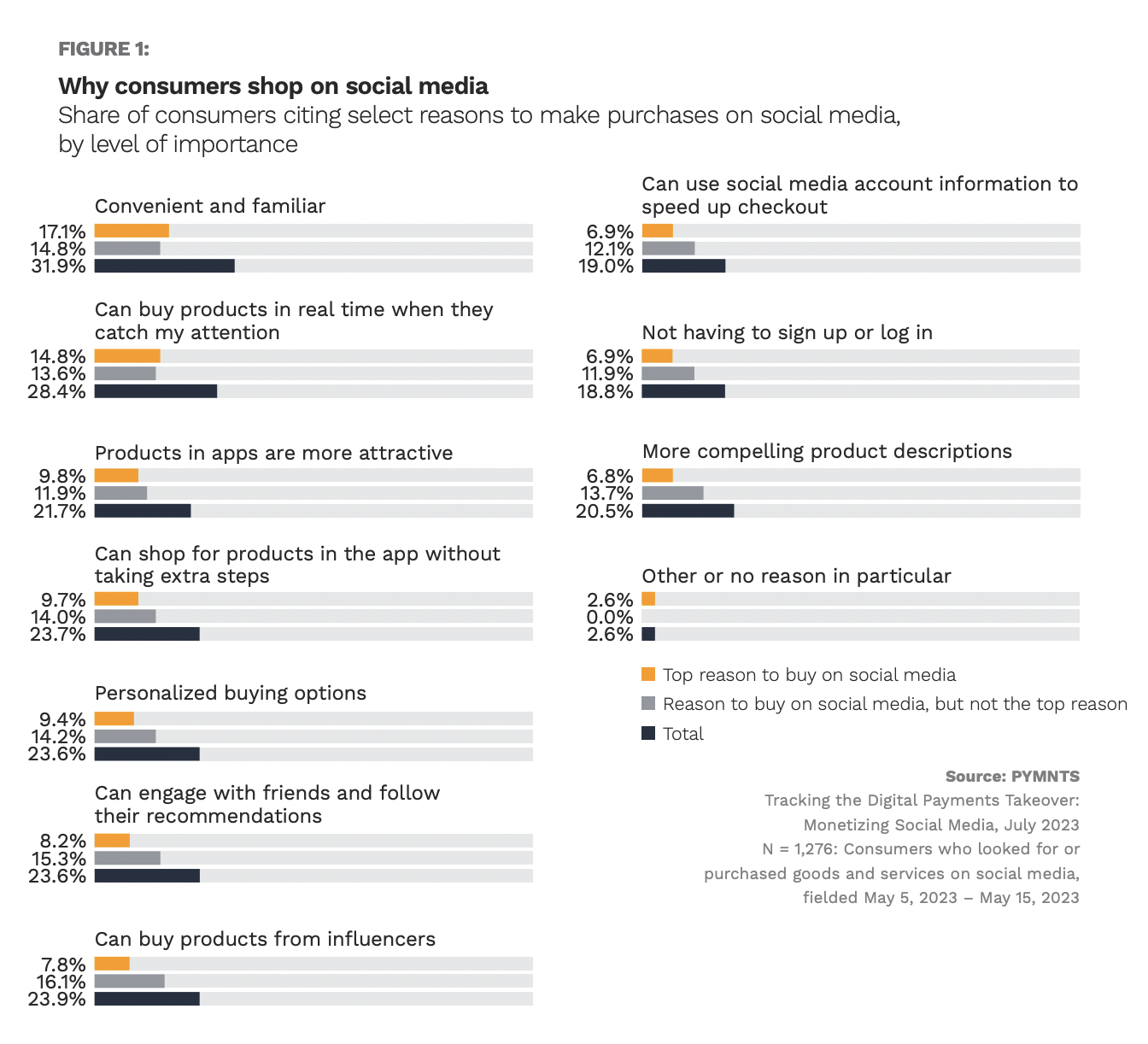Social Media Shoppers Like to Stick With What They Know

For consumers making purchases via social media platforms, PYMNTS Intelligence research reveals, staying within their comfort zone is a top priority.
By the Numbers
PYMNTS Intelligence’s study “Tracking the Digital Payments Takeover: Monetizing Social Media,” created in collaboration with Amazon Web Services, drew from a census-balanced survey of nearly 3,000 U.S. consumers seeking to understand the factors driving them to shop on social media, among other matters.

Thirty-two percent of consumers who transact on social media say they do so because it is easy and familiar, the study found — a greater share than said the same of any reason for shopping via these platforms. Plus, a plurality (17%) cited this as the top reason to buy on social media.
When shopping via these apps and websites, users do not have to navigate away from the apps or websites they’re already familiar with to make purchases. Plus, these platforms often streamline the purchasing process, allowing users to make purchases with just a few clicks or taps.
The Data in Context
Brands are seeing the opportunity to capitalize on this demand for easy, intuitive shopping via social media platforms. Sean Knotts, director of global eCommerce at Sonos, noted in an interview with PYMNTS that these kinds of transactions are on the rise.
“One of the trends we’re also starting to see others invest in is native social checkout,” Knotts said. “We see a lot of sessions from paid social coming to the site through these in-app browsers. And so, making sure that we have an experience that is rooted in the ecosystem that they’re already in and allows them to with minimal clicks check out is something that we’re starting to invest in right now.”
Indeed, these channels are gaining ground. In December, it was reported that TikTok had passed the milestone of generating $10 billion in consumer spending, becoming the first non-game mobile app to do so.
Fed Governor Michelle Bowman: Banking Regulations Should Allow Innovation

The regulatory framework should not prevent banks from providing innovative and competitive products and services, Federal Reserve Gov. Michelle W. Bowman said Monday (Feb. 17).
Speaking at the American Bankers Association’s Conference for Community Bankers in Phoenix, Bowman said that while the framework must promote safety and soundness in the banking system, it should not impede banks’ operations.
“Our work to maintain an effective framework is never really complete,” Bowman said in a speech to be delivered at the event. “Just as complacency can be fatal to the business of a bank, complacency can also prevent regulators from meeting their statutory obligation to promote a safe and sound banking system that enables banks to serve their customers effectively and efficiently.”
In terms of bank supervision, Bowman said supervisory ratings have led to a de-prioritization of core financial risks. Pointing to a Fed report that said most large financial institutions met supervisory expectations with respect to capital and liquidity but only one-third had satisfactory ratings across all relevant ratings components, Bowman said this raised a question about whether non-core and non-financial risks had been over-emphasized.
When it comes to bank applications, Bowman said the process may have created impediments that have led to a current lack of new bank formation. She added that regulators could improve the process by developing specialized expertise, streamlining the application process and improving transparency.
In the case of mergers and acquisitions, Bowman said “the purgatory of a long application process” could be remedied by updating application forms to include all the information that is needed and by adhering to fixed approval timelines.
Addressing regulation, Bowman said that the body of regulations applied to banks has grown dramatically since the 2008 financial crises and that some of those regulations may be outdated, unnecessary and overly burdensome.
“The banking system can be an engine of economic growth and opportunity, particularly when it is supported by a bank regulatory framework that is rational and well-maintained,” Bowman said. “The work of rationalizing and maintaining this system is an ongoing cycle. While my remarks today have touched on a wide range of issues that require rationalization and ‘maintenance,’ this is by no means an exhaustive list.”